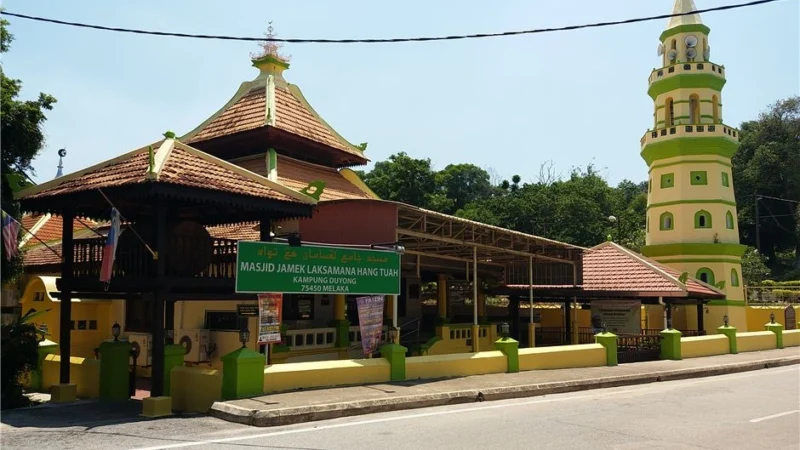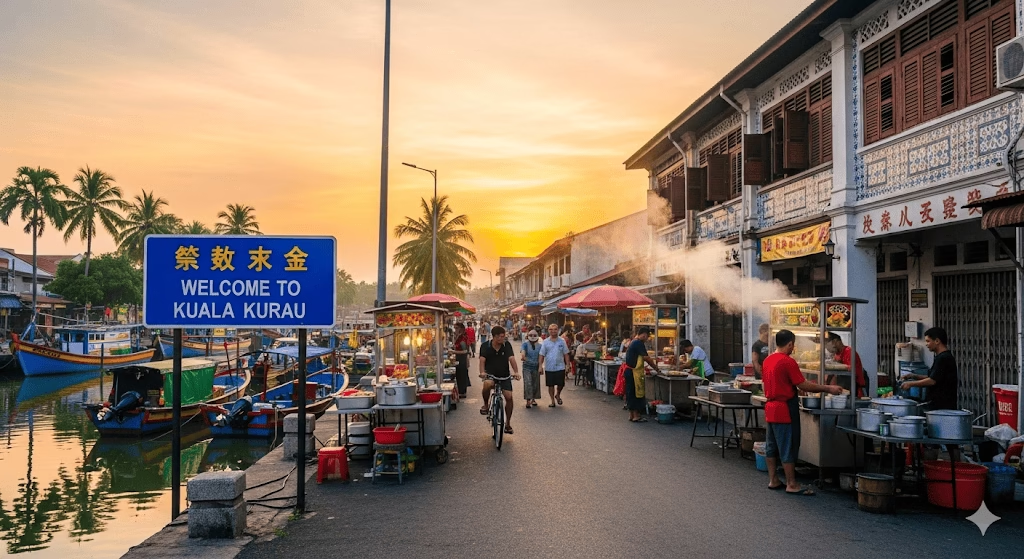Masjid Jamek Laksamana Hang Tuah Kampung Duyong – A Historic Mosque Honouring Melaka’s Legendary Warrior

Introduction
Nestled in the peaceful village of Kampung Duyong, Melaka, the Masjid Jamek Laksamana Hang Tuah stands as a timeless symbol of faith, history, and cultural pride. Once known as Masjid Duyong, this mosque is among the 54 historic mosques in Melaka, built in honour of Hang Tuah, the legendary warrior of the Melaka Sultanate. With its traditional Malay architectural charm and centuries-old heritage, the mosque remains one of Melaka’s most significant spiritual and cultural landmarks.
History of Masjid Jamek Laksamana Hang Tuah
The origins of Masjid Jamek Laksamana Hang Tuah date back to 1850, when it was built by the local villagers under the leadership of Wan Chilek, the village headman. The mosque’s construction began after Melaka was handed over from the Dutch to the British, during the early formation of the British Straits Settlements.
Over the decades, the mosque underwent several renovations and expansions to preserve its structure and accommodate more worshippers:
- 1909: Construction of a minaret on the southeast side.
- 1960–1961: Major renovation works, including replacing the old clay roof tiles, adding a new staircase, ceiling finish, and an ablution pond.
- 1973 & 1976: Expansion projects to meet the increasing needs of the local Muslim community.
- 1982: A fire damaged parts of the mosque, though the main building remained structurally intact.
- 1991: Further extensions added on the eastern side.
- 2002: Conservation works carried out to restore and preserve the mosque’s heritage features.
- 2010: The mosque was officially renamed Masjid Jamek Laksamana Hang Tuah to honour Melaka’s most revered warrior, Laksamana Hang Tuah.
Architectural Highlights
Masjid Jamek Laksamana Hang Tuah showcases traditional Melaka Malay vernacular architecture, easily recognizable by its tiered roof design and pagoda-style minaret—a style inspired by a blend of Malay, Javanese, and Chinese influences.
Notable architectural features include:
- Multi-tiered roof: Built using clay tiles, offering excellent ventilation and natural cooling.
- Pagoda-style minaret: Constructed in 1909, representing a rare architectural style in mosque design within Melaka.
- Elaborate pinnacle: Originally made from carved coral stone, later replaced with a steel crown during restoration.
- Traditional timber craftsmanship: Reflecting the skilled artisanship of 19th-century Malay builders.
The mosque has been carefully conserved to retain its original identity while ensuring durability against modern environmental challenges.
Cultural and Religious Significance
The mosque’s location, near the Hang Tuah Centre—a museum and cultural complex dedicated to the legendary warrior and his comrades—enhances its cultural importance. The centre celebrates Hang Tuah’s legacy through exhibits, performances, and traditional Malay architecture.
Masjid Jamek Laksamana Hang Tuah continues to function as a place of worship and a heritage landmark, attracting locals, historians, and tourists eager to experience Melaka’s Islamic heritage. It stands as a living reminder of Melaka’s golden era, where culture, faith, and tradition coexisted harmoniously.
Visiting Information
Location:
Masjid Jamek Laksamana Hang Tuah, Jalan Semabok Dalam, Kampung Duyong, Melaka, Malaysia
Getting There:
- Approximately 10–15 minutes from Melaka city centre by car.
- Accessible via Jalan Tun Kudu or Jalan Semabok.
- Located adjacent to the Hang Tuah Centre, making it an ideal stop on any Melaka heritage tour.
Nearby Attractions:
- Hang Tuah Centre
- Kampung Morten (traditional Malay village)
- Melaka River Cruise
- Stadthuys and Christ Church Melaka
Tips for Visitors
- Dress modestly when entering the mosque.
- Non-Muslims are welcome to visit outside prayer times.
- Photography is permitted, but always seek permission before entering prayer areas.
- Combine your visit with a trip to the Hang Tuah Centre for a deeper historical experience.
Frequently Asked Questions (FAQ)
1. When was Masjid Jamek Laksamana Hang Tuah built?
The mosque was originally constructed in 1850 by the villagers of Kampung Duyong.
2. Who was Hang Tuah?
Hang Tuah was a legendary Malay warrior who served under the Melaka Sultanate, renowned for his loyalty, wisdom, and martial prowess.
3. What makes this mosque architecturally unique?
It features a tiered roof and pagoda-style minaret, blending Malay and regional influences rarely seen in modern mosques.
4. Is the mosque open to the public?
Yes, the mosque is open to visitors, especially those interested in heritage and cultural tourism. Visitors are expected to dress respectfully.
5. What are other nearby attractions to visit?
The Hang Tuah Centre, Melaka River, and Kampung Morten are nearby, offering a rich cultural and historical experience.
Conclusion
Masjid Jamek Laksamana Hang Tuah is not merely a place of worship—it is a monument of Melaka’s living heritage. With its historical roots tracing back to the 19th century and its connection to Hang Tuah, the mosque represents a harmonious blend of Islamic devotion and Malay identity. Whether you are a history enthusiast, a cultural explorer, or a spiritual traveller, this mosque offers a truly enriching experience that embodies the soul of Melaka’s Islamic past.















Comments are closed.